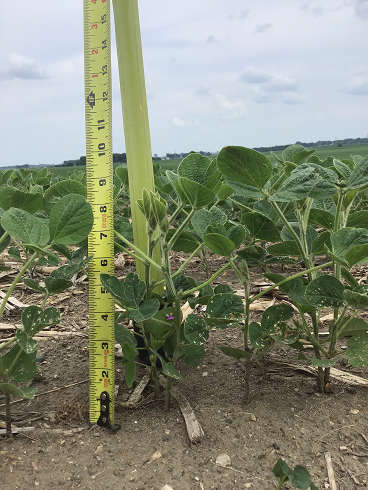Soybean Plant Development
BY Dairyland Seed Agronomy Team
Soybean plant development is ranging from just germinating for replanted soybeans (due to drowned out or other weather impacted areas) or a second crop after peas or winter wheat, to beginning bloom (R1 which is an open flower on any node on the main stem.) Typically, we find that soybean plants are ankle to calf high (4 to 16 inches) by the 4th of July. We may have some early planted and/or early maturing soybeans that are at full bloom (R2 -- an open flower at one of the two uppermost nodes on the main stem that have a fully developed leaf.)

Soybeans are photoperiod sensitive which indicates the plant is influenced by the length of light it receives. This light influence will start the reproductive phase (flowering) shortly before or after summer solstice on June 21. June 21 is the day with the longest day or light length as well as the shortest night or darkness length of the year.
Once soybean plants start the flowering process, they are in the reproductive phase and all growth stages will be listed in the R stage (R1, R2, etc.) Soybeans will continue to put on vegetative growth (V stages) until the R 5.5 stage. For this reason, it is common for some agronomists to stage some early flowering plants in both vegetative and reproductive stages (example V8 and R1). Soybean plants can start the flowering process at V2 to V8 depending on the growing season and conditions.
As the soybean plant is flowering and putting on vegetative growth above ground, below ground the root system is growing rapidly. In ideal growing conditions, it is common to find soybean roots two to three feet deep and 18 to 24 inches in width. Nodulation, another below ground activity, which started at V1 (first trifoliate) is ramping up to kick into high gear at R2. Conversely, if you have excess nitrogen in the soil, the soybean plant will decrease the number of nodules it produces and subsequently the amount of nitrogen from nodulation available to the plant this year as well as next year’s planted crop.

Brian Weller
Western Region
507.456.3034

Rod Moran
Western Region
507.456.3034

Dan Ritter
Central Region
219.863.0583

Branden Furseth
Northern Region
608.513.4265

Mark Gibson
Eastern Region
260.330.8968

Amanda Goffnett
Eastern Region
989.400.3793

Ryan Mueller
Eastern Region
989.400.3793
